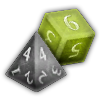Damage: Difference between revisions
| Line 12: | Line 12: | ||
== Damage rolls == | == Damage rolls == | ||
{{Excerpt|Dice rolls| | {{Excerpt|Dice rolls|Damage rolls|subsections=yes|templates=SAI, InfoBlob, note}} | ||
=== Example === | === Example === | ||
Revision as of 20:44, 9 January 2024
Damage is a number that represents how deadly a threat is. When a creature takes damage, they subtract that amount of damage from their current amount of hit points.
Damage is dealt with attacks and other harmful actions, as well as by a variety of conditions.
Damage rolls
The base damage dealt by a weapon, spell, class action, or condition is usually determined by a damage roll. Damage rolls always have an associated damage type that is given following the dice notation, e.g. .
Damage modifiers
Modifiers added to damage rolls are only added per source, even if multiple dice are rolled.
Which ability score modifier is added to a damage roll depends on the attack:
- When making weapon attacks, the attacking creature usually adds the ability score modifier that they added to the attack roll.
- Ability score modifiers are not normally added to damage rolls dealt by spells or spell attacks, unless specifically stated otherwise in the spell's description, or if enabled by some feature, such as .
Example
A successful attack with a ![]() Dagger does a base of 1d4
Dagger does a base of 1d4![]() Piercing damage (1~4). This means a single four-sided die
Piercing damage (1~4). This means a single four-sided die ![]() is rolled to determine the damage, for a total of 1 to 4 piercing damage. Most weapons use a single damage die, but some two-handed weapons use two: a successful attack with a
is rolled to determine the damage, for a total of 1 to 4 piercing damage. Most weapons use a single damage die, but some two-handed weapons use two: a successful attack with a ![]() Greatsword does 2d6
Greatsword does 2d6![]() Slashing damage (2~12), rolling two six-sided dice
Slashing damage (2~12), rolling two six-sided dice ![]() for a total of 2 to 12 slashing damage. Damaging spells typically roll more dice: for example, being caught in a will cause 8d6
for a total of 2 to 12 slashing damage. Damaging spells typically roll more dice: for example, being caught in a will cause 8d6![]() Fire damage (8~48), though a successful Saving Throw can reduce it to half.
Fire damage (8~48), though a successful Saving Throw can reduce it to half.
Damage types
All damage has a damage type, of which there are 13:
Bludgeoning, piercing and slashing damage are sometimes collectively referred to as Physical damage.
If a source of damage mixes different sizes of dice or damage types, they will be listed separately with a plus sign between them, e.g. 1d8![]() piercing + 1d4
piercing + 1d4![]() fire. Each type is dealt separately, though see damage mechanics for more details.
fire. Each type is dealt separately, though see damage mechanics for more details.
Resistance, Vulnerability and Immunity
A creature's resistances determine which damage types they are immune, resistant or vulnerable to:
- Damage dealt to a creature with resistance to that damage type is halved.
- Damage dealt to a creature with vulnerability to that damage type is doubled.
- Damage dealt to a creature with immunity to that damage type is reduced to zero.
Resistance and vulnerability to the same type cancel each other out, but don't affect immunity.
A bit of mathematics
Note that due to the mathematics of dice rolls, the difference between, say, 1d8 and 2d4 is more than just the higher minimum value of 2 on the 2d4 roll. With the d8, you have an equal chance of getting, say, a 5 and an 8. On the other hand, the 2d4 roll is statistically more likely to lead to a total value of 5, than a total value of 8. This is most easily explained with a table of all possible outcomes:
| First roll | Second roll | Total value |
|---|---|---|
| 1 | 1 | 2 |
| 1 | 2 | 3 |
| 1 | 3 | 4 |
| 1 | 4 | 5 |
| 2 | 1 | 3 |
| 2 | 2 | 4 |
| 2 | 3 | 5 |
| 2 | 4 | 6 |
| 3 | 1 | 4 |
| 3 | 2 | 5 |
| 3 | 3 | 6 |
| 3 | 4 | 7 |
| 4 | 1 | 5 |
| 4 | 2 | 6 |
| 4 | 3 | 7 |
| 4 | 4 | 8 |
Notice how often the 5 appears in the possibilities for the total value (4 out of 16 possibilities) vs. how often the 8 appears (1 out of 16). This means a 2d4 roll has a 25% chance of resulting in 5 points of damage, but only a 6.125% chance of resulting in 8 points of damage. Meanwhile, the 1d8 roll actually has a higher chance of resulting in the maximum damage value of 8, since 1 out of 8 possibilities (12.5%) result in an 8. However, the average roll of 2d4 is 5 damage, while the average roll of is only 4.5, because 2d4 can never roll a 1. Therefore, 2d4 is generally more consistent in damage output and will result in higher rolls in the long run.
See also
Footnotes
